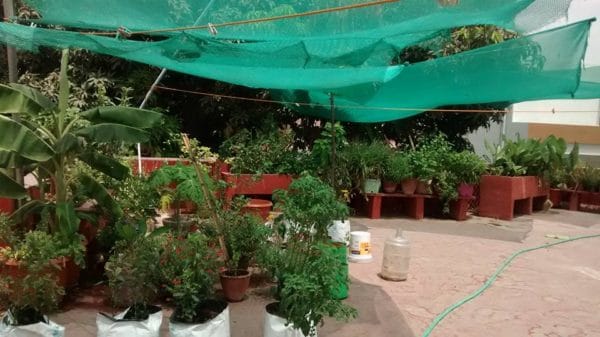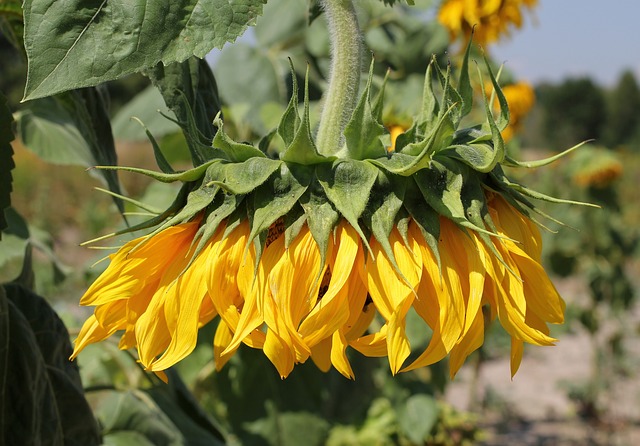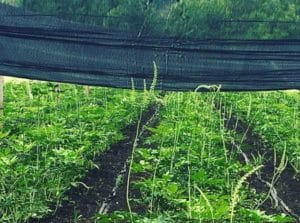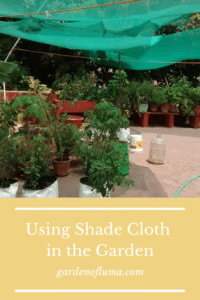When to Use Shade Cloth in the Garden

If you’ve attempted any type of gardening in the desert or a hot, dry climate, you know that in the summer months, shade is your friend. For many climates, getting the most amount of sun as possible is important for plant growth, but when are you consistently over 100 degrees Fahrenheit, your plants will appreciate some relief from the scorching sun. Not all plants are created equal so it’s important to know when to start applying shade or how much shade to provide.
When Should I use a shade cloth in the garden? When you start to see signs of stress, like frequent wilting or leaves starting to scorch, caused by excessive sun, then it’s time to use shade cloth. It’s typically when the temps become hotter than normal or extreme. When temps are in the triple digits Fahrenheit this is a good indicator that relief from the sun is needed.

Should I completely Shade my tree or plant?
Keep in mind that plants need sunlight, so it may be tempting to put your plant in full shade when it’s hot, but the plant isn’t going to get those needed sun rays, causing problems to the photosynthesis process. So, providing shade relief should still allow for some light penetration, but just reducing the intensity levels of the sun light. It’s OK to move your plant from a place where it’s getting all day full sun, to a spot that provides shade for half the day, because it’s still allowing for some sun. If you were to completely shade out the plant during the day for a period of time, it’s going to have to be re-acclimated to sun later on.
What is shade cloth?

A Shade cloth is a woven fabric that is typically made up of polyester materials. They can trap heat in, so if using for a greenhouse, it’s best to utilize shade cloth made of polyethylene. Aluminet is also a great option for greenhouses. An aluminet is made from HPDE which is highly reflective. This material almost mimics acting like a reflective mirror. Here is a breakdown of the three major types of shade cloths:
Woven-A woven shade cloth can be a little heavier than other materials and is made from woven polypropylene material. These kinds of shade cloths are more geared towards greenhouse use and can last up to 12 years. They appear more plastic like and tend to be more heavy duty, but come with a higher cost.
Knitted– Generally lighter weight then other varieties of shade cloth which can make it easier to work with. Knitted shade clothes tend to come in more color variants other than the standard black. Knitted shade cloths can resemble a cloth in appearance. They typically can last up to 10 years.
Aluminet-This category of shade cloth has become increasingly more popular. Again, it’s going to be more for patios, greenhouses, or large structures, versus a small raised garden bed. Aluminet is more effective with keeping both light levels down as well as temperature. Since it’s reflective and doesn’t absorb, it can help keep plants cooler. Aluminet is also very durable.
A percentage is often associated with the shade cloth ranging from 5%-95%. This designates the amount of sun light the shade cloth deflects. So for a 95% shade cloth, a plant would be getting 5% of the sunlight that it would get without a shade cloth present.
How do I use shade cloth?
It’s important to keep the shade cloth off of the plant. If the cloth is draped directly on the plant it can cause the leaves to burn or trap too much heat in. You want to have some air flow under the shade cloth. It’s best to build or utilize some sort of structure over the plant or tree to create a canopy with the shade cloth. I utilize four wooden stakes around my fruit tree and drape the cloth over top of the four posts.

What shade cloth is best for my plants?
In our intense desert sun, it’s better to go a little higher with the percentage. I’ve had good success utilizing 30-50% shade cloth on many of my young fruit trees or plants that have needed some sun relief. For more sensitive plants I’ve used a much higher percentage. On my young Loquat tree, while it was getting established the first couple years, I utilized 80% shade. It also was planted in a location that it receives some afternoon shade without a cloth. So, a lot depends on the type of plant or fruit tree, as well as the age. Here are a few shade cloths that I recommend checking out:
Agfabric 50% Sunblock Shade Cloth Cover with Clips for Plants 12’ X 20’, Black

E.share 40% Black Shade Cloth Taped Edge with Grommets UV 10 ft X 20 ft

Rovey 70% 10ft x 12ft Knitted Aluminet Shade Cloth Panels Sun Block Reflective

To summarize, when gardening in hot, dry climates the sun can become unbearable for many fruit trees and plants in the midst of summer. Giving your plants some relief from the scorching sun can mean life or death for your plants. By utilizing a simple shade cloth, it can make all the difference in helping your plants to survive.
Related Question
What are some Tips for Protecting Plants from Heat?
Utilize your Microclimates
If you know that a plant or fruit tree is more sensitive to sun, then plant them in areas of your yard that already has some established shade from other large trees, structures, or how that spot faces the sun. Check out my post on the Importance of Microclimates.
Grow into the Sun
When plants are young they are working hard to establish root systems. During this time any added stress, like intense sun, can cause the plant to struggle. It can be beneficial to plant in an area that allows the plant to establish first while slowly growing into full sun.
Wind Protect
Our hot, dry winds can suck the life out of plants. It’s a good idea to utilize other trees our high density planting to help minimize problems from wind.
Mulch
Adding a thick layer of mulch can help to keep the roots of your plants or trees several degrees cooler. Mulch helps to retain moisture in the soil to keep your trees hydrated. As you moisten the mulch it can provide a little extra humidity around the plant.
Plant Heat Tolerant Plants
Some fruit trees and plants can tolerate our desert sun without problems. Identifying these types of plants will help make things that much easier when it comes to growing in high heat conditions. Melons, pomegranates, figs, mulberries, jujube’s, sweet potatoes, peppers, are just a few things that do well in full desert sun when properly cared for.
Please comment below on anything that you’ve enjoyed from this post or experiences utilizing shade cloth in the garden.
